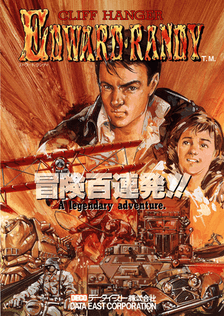The Cliffhanger: Edward Randy
| The Cliffhanger: Edward Randy | |
|---|---|
|
Japanese arcade flyer of The Cliffhanger: Edward Randy. | |
| Developer(s) | Data East |
| Publisher(s) | Data East |
| Composer(s) |
Akira Takemoto Tatsuya Kiuchi Tomoyoshi Sato |
| Platform(s) | Arcade |
| Release date(s) |
|
| Genre(s) | Action-adventure game |
| Mode(s) | 1-2 players (Cooperative) |
| Cabinet | Upright |
| Display | Raster, Horizontal Standard Resolution |
The Cliffhanger: Edward Randy, known in Japan simply as Edward Randy (エドワードランディ edowādo randi), is a side-scrolling action-adventure arcade game only released in Japan by Data East in 1990; however, several world revisions in English exist.
History
The game is set in a steampunk (or, rather, dieselpunk) worldview, where many scenes and settings are directly modeled after Indiana Jones and the Last Crusade, including a whip-wielding main character, Nazi-like enemy army, and battles that take place on biplanes, as well as boats in a Venice-like location. The game also contains parodies or homages to works by Hayao Miyazaki and Buster Keaton. The game also uses a movie-like effect where upcoming in-game events are previewed in the game's background. Unlike some of the other comedic, non-sensical Data East games like Trio The Punch or Chelnov, Cliffhanger is quite serious in its design and plot-line. However, it is still possible to complete almost all of the scenes by only using the spinning attack, so the game system is not too complex. As the game's slogan Ikinari climax (いきなりクライマックス ikinari kuraimakkusu, lit. "Immediate climax") suggests, the emphasis lies in the game's exciting visual properties rather than difficulty or complexity in gameplay.
In-game description
Plot
The game takes place during the 1930s in an unspecified European country. Research on a secret weapon of mass destruction was being conducted in this country under the leadership of a fearsome army general, the Dark Ogre, but an elderly scientist decides to escape after learning that he was being manipulated by the general. The scientist gives the key piece of his research, a prism stone, to his granddaughter Charlotte as he escapes, and the general pursues the prism with the full force of his army. Charlotte takes refuge in the home of Edward Randy, a teenage boy who was preparing for his first date in half a year with his girlfriend, Jennifer, while Edward suddenly finds himself in the midst of a huge adventure involving a dangerous plan to destroy the world.
Gameplay

The player controls the main character using an 8-way joystick and 2 buttons, one for attacking and one for jumping. The main character attacks using a whip, and he can attack in 8 different directions depending on the direction pressed on the joystick. He can also slide on the ground when the jump button is pressed while the joystick is pressed to the side or diagonally downwards. Pressing the joystick diagonally upwards causes the character to run quickly, and pressing down on the joystick while the character is in the air allows him to stomp on enemies on the ground. The character can also do a spin-attack by looping their whip on other objects and holding left or right on the joystick. The character is invincible while they are spinning, but can only spin 4 times per attack.
The game is completed when the player finishes all 7 levels, and up to 2 players can play together at a time. There are no lives in the game, and the main character's remaining health is directly linked to the number of points gained by the player on each level. The player can revive the main character's health by killing more enemies, and they lose points along with health when they are hit by enemy attacks. The player is taken to the game over screen when their points (health) reaches 0. Therefore, the high score is calculated as the highest number of points the player had at any point in the game rather than the number of points they have at the end of the game.
The game's story-line is explained in demo screens that appear in-between levels. The level's subtitle is displayed before the start of each level.
Ports and related releases
- The game was slated to be ported to the Sega Saturn in 1998 by XING Inc., but this plan never came to fruition. As of that scheduled year, the game has not been ported to any consumer console.
- Guardian Heroes includes two characters named Edward M. Cognac and Randy M. Green because Guardian Heroes character designer, Tetsuhiko "HAN" Kikuchi (漢炎剣) was a fan of the arcade game. Gunstar Heroes, another game designed by HAN, also shows influences from the game.
- Edward Randy appears as a computer-controlled character in the 1999 video game Sennou by Kaneko.
- The chapter subtitles in Soichiro Kuzuki's story mode game in Fate/tiger colosseum are taken directly from the subtitles of The Cliffhanger: Edward Randy.
- An official soundtrack titled Edward Randy / Super Burger Time was released on April 21, 1991, and was published by Pony Canyon and Scitron Label. This soundtrack includes every song heard in The Cliffhanger: Edward Randy, as well as every song heard in Super BurgerTime. It also includes a couple of arranged songs.
External links
- The Cliffhanger: Edward Randy at MameWorld.Net
- The Cliffhanger: Edward Randy at arcade-history.com
- The Cliffhanger: Edward Randy at the Killer List of Videogames
- The Cliffhanger: Edward Randy at Hardcore Gaming 101
